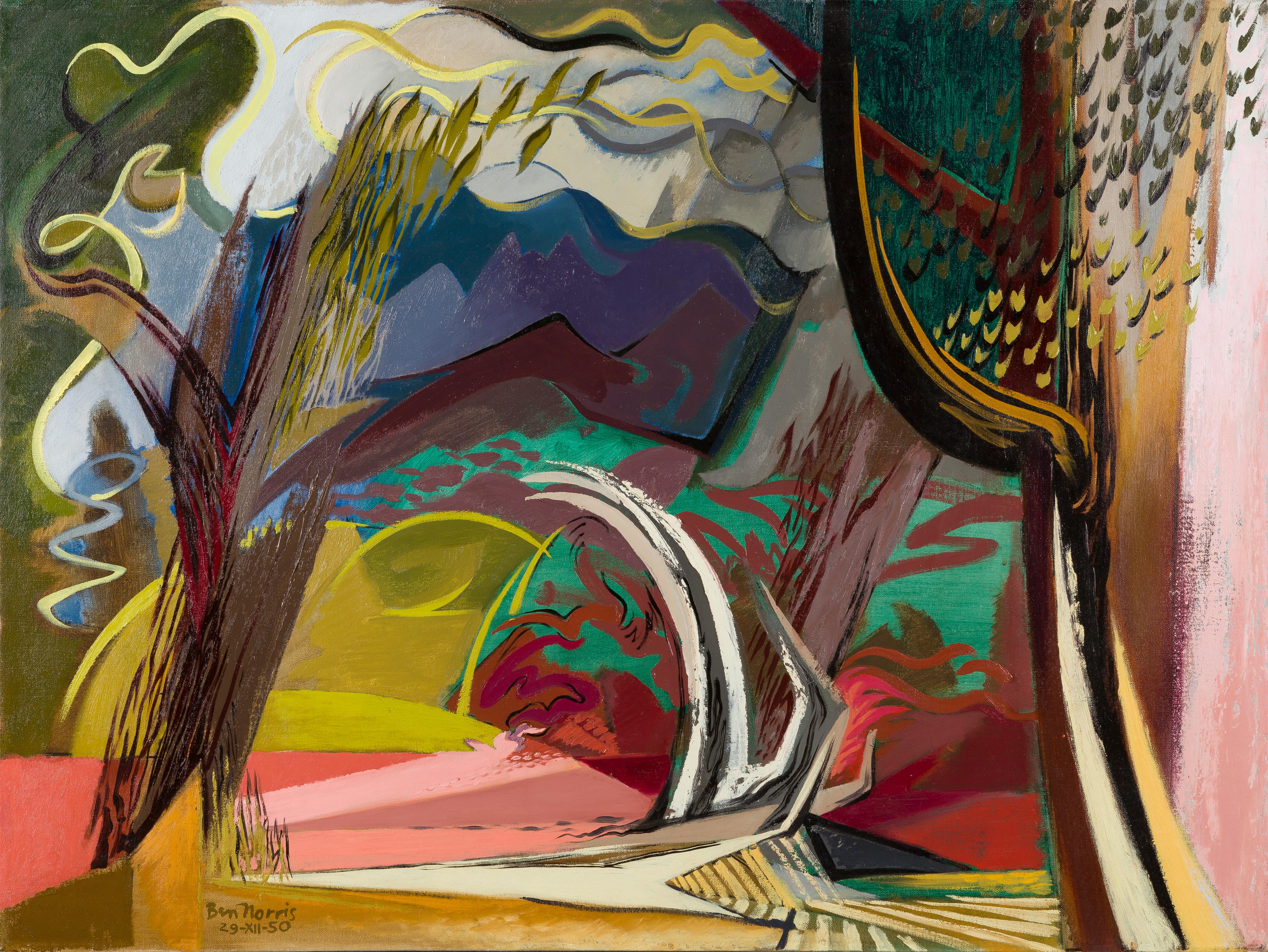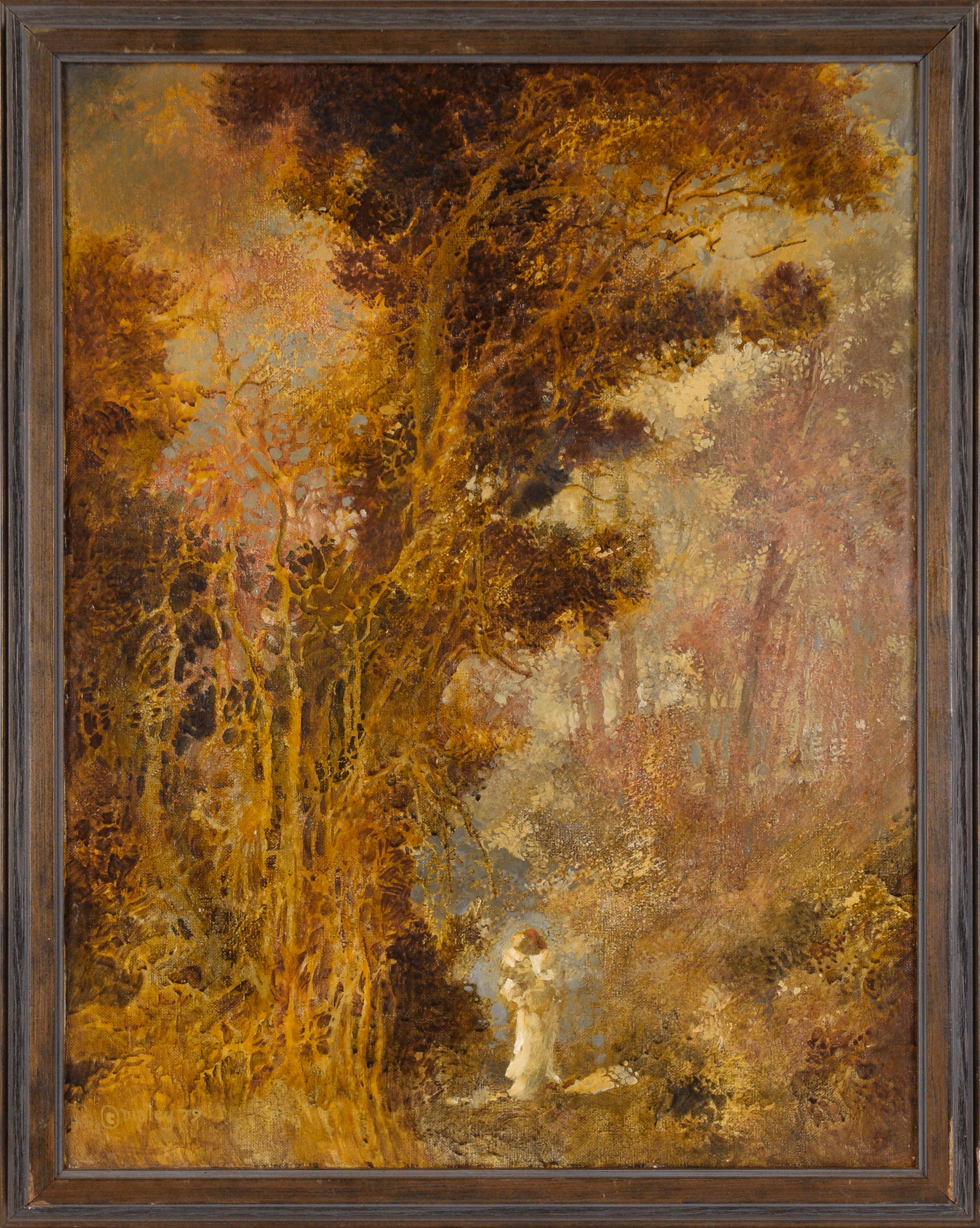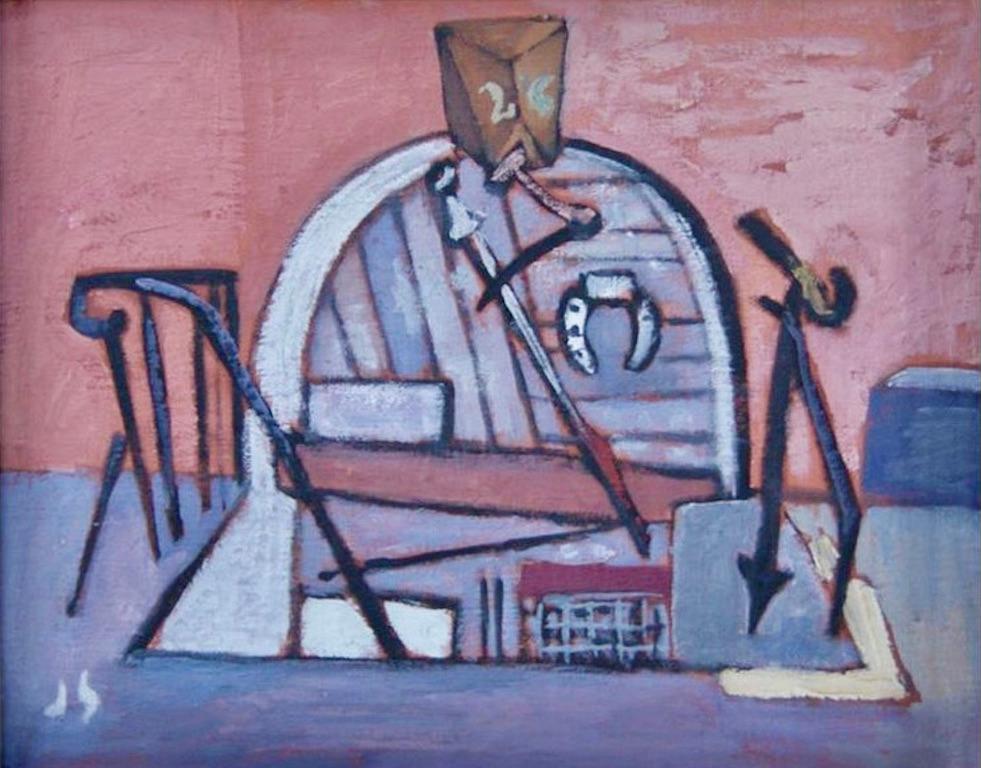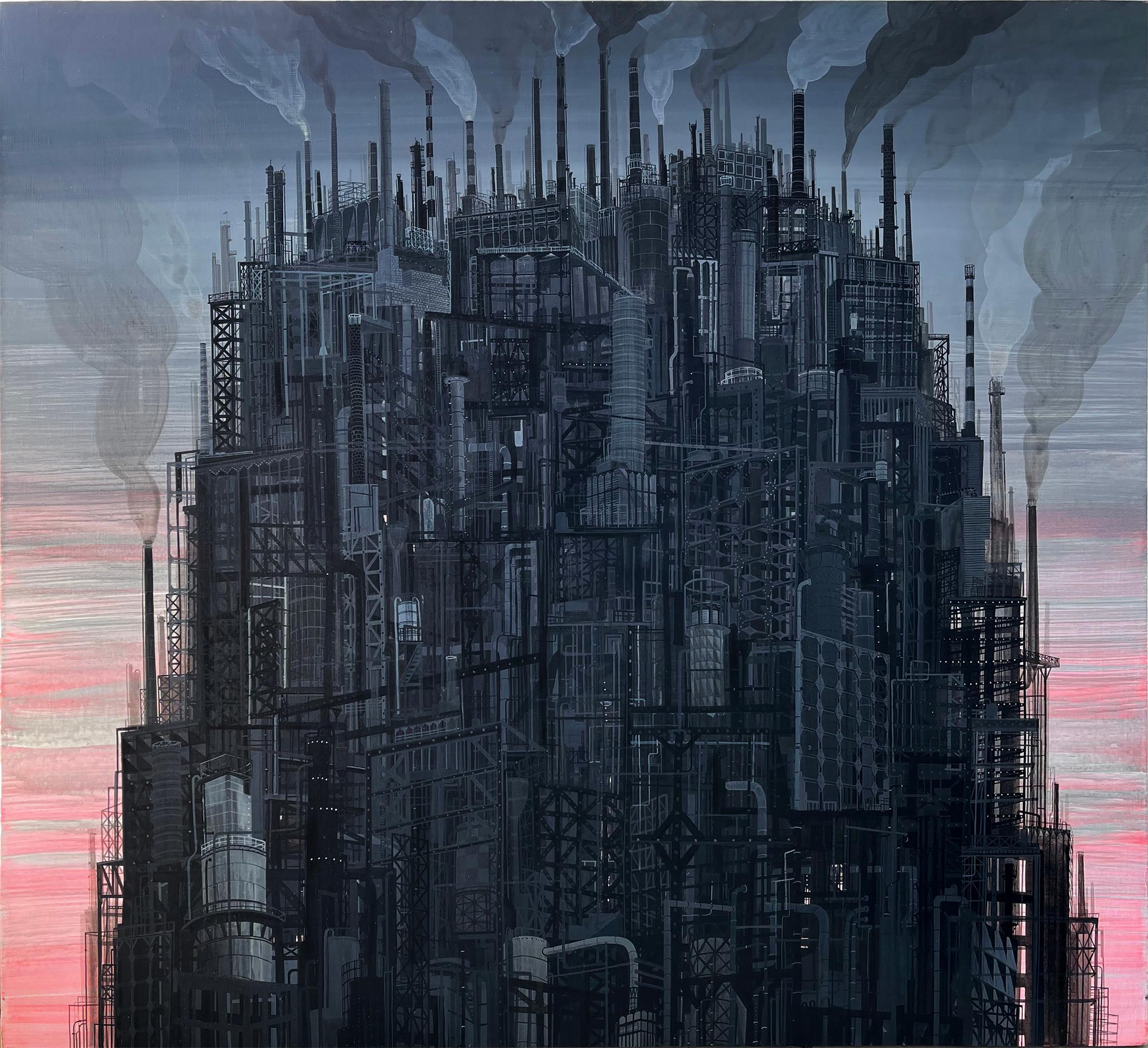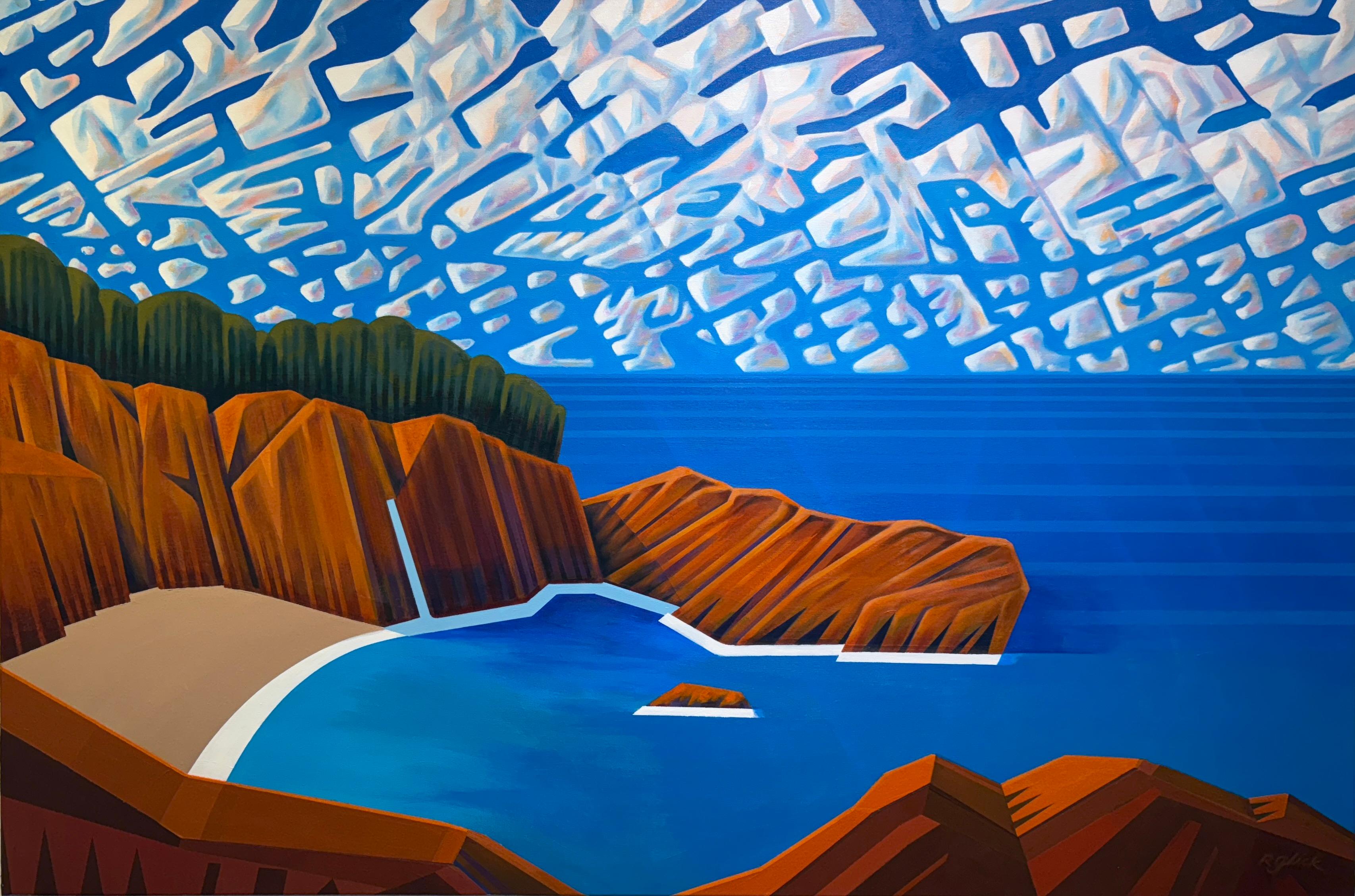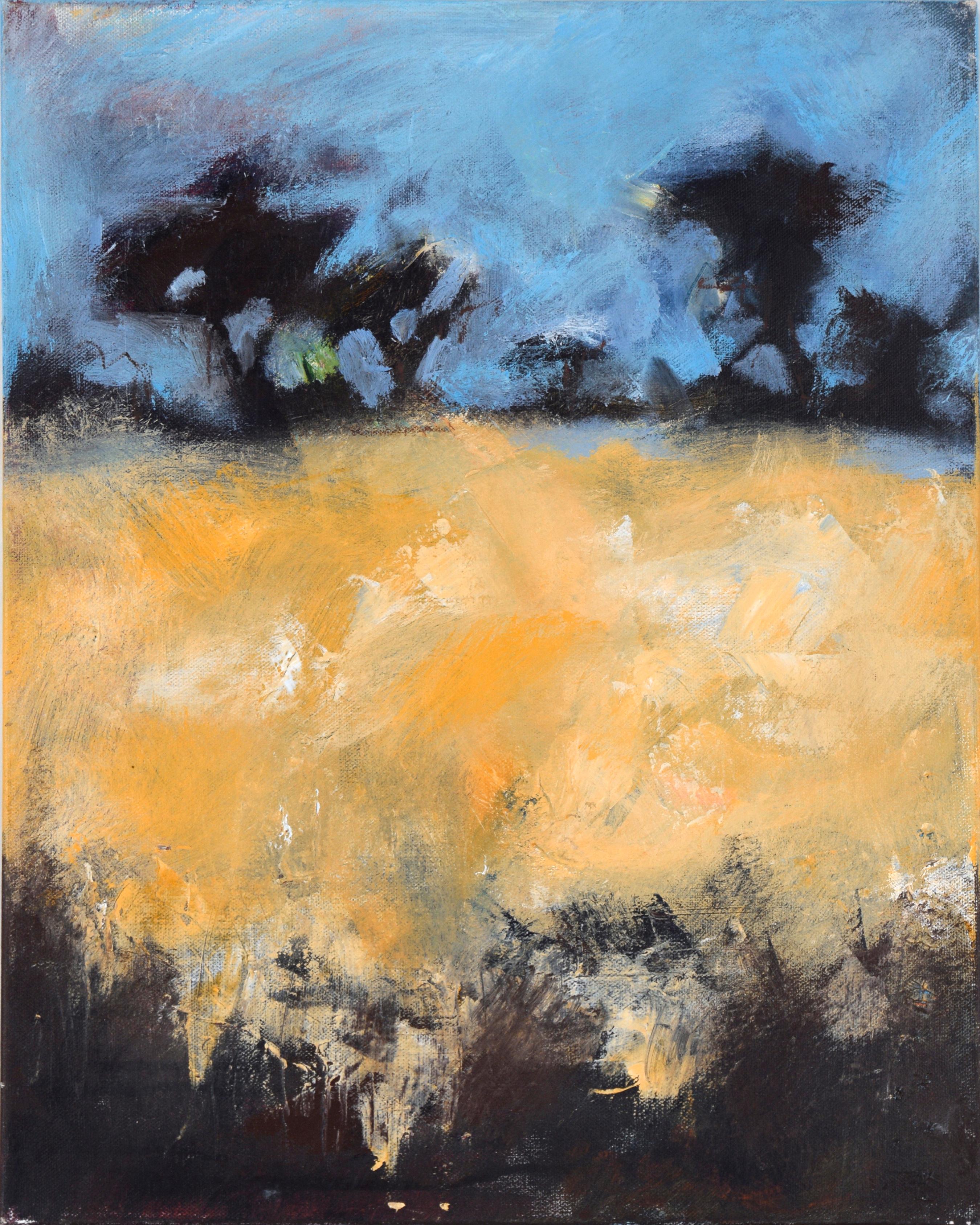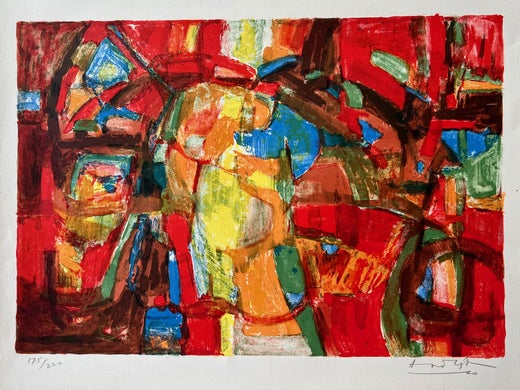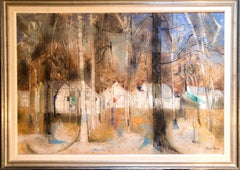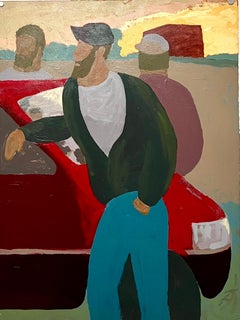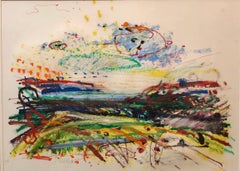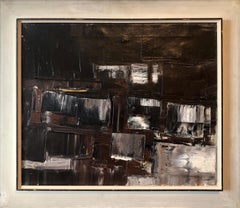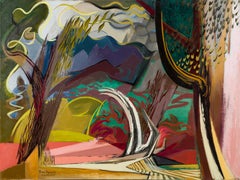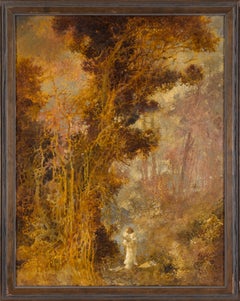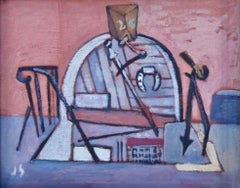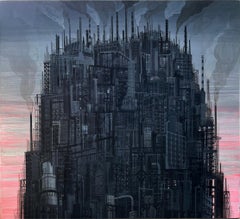Items Similar to Modernist Abstract Expressionist Watercolor Painting Bauhaus Weimar Pawel Kontny
Want more images or videos?
Request additional images or videos from the seller
1 of 5
Pawel KontnyModernist Abstract Expressionist Watercolor Painting Bauhaus Weimar Pawel Kontny
About the Item
Abstract watercolor composition bearing the influence of the earlier color-block compositions of Paul Klee.
Pawel August Kontny, (Polish-German-American artist) He was born in Laurahuette, Poland, in 1923, the son of a wealthy pastry shop owner. In 1939 he began studying architecture in Breslau where he was introduced to the European masters and to the work of some of the German Expressionists, soon afterward banned as "degenerate artists" and removed from museums throughout Germany by the Nazi regime. His studies were interrupted by World War II. Drafted into the German army, traveling in many countries as a soldier, he sketched various landscapes but in 1945, he was captured and held as a prisoner of war in Italy. After the war, he studied at the Union of Nuremberg Architects to help design buildings to replace ones destroyed in the war. He recorded his impressions of the local population and the landscapes through his watercolors and drawings. Pawel Kontny thereafter moved to Nuremberg, Germany, becoming a member of the Union of Nuremberg Architects and helping to rebuild the city's historic center. He soon decided to concentrate on his professional art career. He married Irmgard Laurer, a dancer with the Nuremberg Opera. Pavel Kontny 's career as an artist was launched with his participation in an all German exhibition, held at the Dusseldorf Museum in 1952. He held one-man shows in Germany, Switzerland and the United States. During his trip to the United States in 1960, Kontny became instantly enamored with Colorado, and decided to relocate to Cherry Hills with his wife and two children. He quickly established himself in the local art community, being affiliated for a time with Denver Art Galleries and Saks Galleries. His subject matter became the Southwest. During this time he received the Prestigious Gold Medal of the Art Academy of Rome. His extensive travel provided material for the paintings he did using his hallmark marble dust technique. he also worked equally in pastel, watercolor, charcoal and pencil-and-ink. in a style which merged abstraction and realist styles, influenced by Abstract Expressionist painting and South Western American landscapes. In the early 1960s he was one of only a few European-born professional artists in the state, a select group that included Herbert Bayer (1900-1985), a member of the prewar Bauhaus in Weimar and Dessau, Germany, and Roland Detre (1903-2001), a Hungarian modernist painter. As a Denver, Colorado resident, Pavel Kontny exhibited at galleries and museums throughout the United States, Germany and Japan. There, he was inspired by frequent trips to Native American pueblos in the Southwest, as well as by the study of the Plains Indians of Montana and Wyoming. Over the years Kontny had a number of students and generously helped young artist by hosting exhibitions at his Cherry Hills home. For many years he generously donated his paintings to support charitable causes in Denver. Influences during his European years included German pastelist C.O. Muller, German Informel painter Karl Dahmen and Swiss artist, Hans Erni. In the early 1950s his painting style showed the influence of the Die Brücke (The Bridge), a group of German expressionist artists formed in Dresden in 1905 who had a major impact on the evolution of modern art in the twentieth century in Germany. By the middle of the decade his style incorporated more referential abstraction and total abstraction, resulting in part from his study of Hans Hartung, a German artist based in Paris who exhibited his gestural abstract work in Germany. The American moon landing in 1969 inspired Paul Kontny to create Cosmic, the first of his many abstract compositions of the universe, an oeuvre also figuring prominently in Vance Kirkland’s creative output. He traveled widely as well, visiting the major museums in Germany, France, Spain and England and searching for subject matter in Italy, Yugoslavia, Greece and North Africa. By the time he arrived in Denver, he had an impressive European resumé of affiliations with the Schöninger and Stenzel Galleries in Munich, and shows at galleries and museums in Dusseldorf, Essen, Nuremberg, Frankfurt, Stuttgart, Basel and St. Moritz. The Little Studio and Seidenberg Gallery in New York also had exhibited his work. Paul Kontny 's work is included on various private and corporate collections and museums throughout the United States, Europe and Japan.
- Creator:Pawel Kontny (1923 - 2002, Polish)
- Dimensions:Height: 9 in (22.86 cm)Width: 14 in (35.56 cm)
- Medium:
- Movement & Style:
- Period:
- Condition:
- Gallery Location:Surfside, FL
- Reference Number:1stDibs: LU3829739572
Pawel Kontny
A painter of subjects from many parts of the world, Pawel Kontny began with wartime sketches and changed to a technique combining abstraction and realism. He was born in Laurahuette, Poland, the son of a wealthy pastry shop owner. He studied architecture, but was interrupted by World War II. Traveling in many countries as a soldier, he sketched various landscapes but in 1945, he was captured and held as a prisoner of war in Italy. After the war, he studied at the Union of Nuremberg Architects to help design buildings to replace ones destroyed in the war. He also married Irmgard, a dancer with the Nuremberg Opera Company and began having well received exhibitions of his work throughout Europe. His primary subject became architecture which he built up on heavy weight masonite panels into structures with marble dust. In 1969, the Kotnys moved to Denver, Colorado where he began painting the American West. In February, 1974, "American Artist" magazine had a feature article by John Jellico on Pawel Kontny.
About the Seller
4.9
Platinum Seller
Premium sellers with a 4.7+ rating and 24-hour response times
Established in 1995
1stDibs seller since 2014
1,750 sales on 1stDibs
Typical response time: 2 hours
- ShippingRetrieving quote...Shipping from: Surfside, FL
- Return Policy
Authenticity Guarantee
In the unlikely event there’s an issue with an item’s authenticity, contact us within 1 year for a full refund. DetailsMoney-Back Guarantee
If your item is not as described, is damaged in transit, or does not arrive, contact us within 7 days for a full refund. Details24-Hour Cancellation
You have a 24-hour grace period in which to reconsider your purchase, with no questions asked.Vetted Professional Sellers
Our world-class sellers must adhere to strict standards for service and quality, maintaining the integrity of our listings.Price-Match Guarantee
If you find that a seller listed the same item for a lower price elsewhere, we’ll match it.Trusted Global Delivery
Our best-in-class carrier network provides specialized shipping options worldwide, including custom delivery.More From This Seller
View AllAmerican Woman Artist Modernist Large Oil Painting Cubist Influenced Landscape
By Lena Gurr
Located in Surfside, FL
A beautiful wooded landscape scene with houses and trees.
Painted on a masonite board. hand signed lower right. with framers label verso.
Framed to 40 X 55 inches. 33 X 48 without the frame and mat.
It is not dated.
Lena Gurr (1897–1992), was an American woman artist who made paintings, prints, and drawings During the course of her career Gurr's compositions retained emotional content as they evolved from a naturalistic to a semi-abstract cubist style. Born into a Russian-Jewish Yiddish speaking immigrant family, she was the wife of Joseph Biel, also Russian-Jewish and an artist of similar genre and sensibility. Gurr used Lena Gurr as her professional name. After marrying Joseph Biel she was sometimes referred to as Lena Gurr Biel. Biel had been born in Grodno, Poland (later absorbed into Russia) and had lived in England, France, and Australia before coming to New York. An artist, he specialized in landscape paintings and silkscreen printing as well as photography. He studied art at the Russian Academy in Paris. After immigrating to the United States, he studied under George Grosz at the Arts Students League.
Gurr was born in Brooklyn and, apart from brief stays in Manhattan and in Paris, lived there her whole life. This painting bears the influence of Lyonel Feininger an influential German American artist. Gurr began studying art at a young age. In 1919 she studied painting and printmaking at the Educational Alliance Art School and between 1920 and 1922 she won a scholarship to attend the Art Students League where she took classes with John Sloan and Maurice Sterne.
In 1926 and 1928 Gurr participated in group shows at the Whitney Studio Club in Greenwich Village and in 1928 she also participated in the 12th annual exhibition of the Society of Independent Artists at the Waldorf Roof in New York. (Reviewing this show, Helen Appleton Read, the critic for the Brooklyn Daily Eagle, said "I made three discoveries on my first visit, Thomas Nagel, Eugenie McEvoy and Lena Gurr with two figure compositions which have something of Marie Laurencin or Helene Perdriat quality of naive sophistication.") The Waldorf Roof was a set of rooms on the top floor of the Waldorf Astoria Hotel, one of which had glass sides and a glass roof. The rooms were used for concerts, dances, benefits, and exhibitions.From 1929 to 1931 Gurr took a leave of absence from her teaching position to travel in France with Joseph Biel, an artist whom she had met while studying at the Art Students League. They spent time in Nice and Mentone but mainly in Paris.
During the early months of 1931, while she was still abroad, her work appeared in group exhibitions held at the R. H. Macy department store and the Opportunity Gallery (opened by Gifford Beal). In 1932 she participated in three shows: a solo exhibition at the Brooklyn Museum, an annual exhibition of the New York Society of Women Artists, ( Its first president was Marguerite Zorach. Founding members included Agnes Weinrich, Anne Goldthwaite...
Category
Mid-20th Century American Modern Landscape Paintings
Materials
Oil, Panel
Large Hudson River Figurative Modernist Landscape Oil Painting Edward Avedisian
By Edward Avedisian
Located in Surfside, FL
Edward Avedisian ( 1936-2007 )
Gouache or oil on paper, 3 guys around a car,
hand signed in paint lower left,
Measures 30"x 22.5"
Edward Avedisian (June 15, 1936, Lowell, Massachusetts – August 17, 2007, Philmont, New York) was an American abstract painter who came into prominence during the 1960s. His work was initially associated with Color field painting and in the late 1960s with Lyrical Abstraction and Abstract Expressionism.
He studied art at the School of the Museum of Fine Arts, Boston. By the late 1950s he moved to New York City. Between 1958 and 1963 Avedisian had six solo shows in New York. In 1958 he initially showed at the Hansa Gallery, then he had three shows at the Tibor de Nagy Gallery and in 1962 and 1963 at the Robert Elkon Gallery. He continued to show at the Robert Elkon Gallery almost every year until 1975.
During the 1960s his work was broadly visible in the contemporary art world. He joined the dynamic art scene in Greenwich Village, frequenting the Cedar Tavern on Tenth Street, associating with the critic Clement Greenberg, and joining a new generation of abstract artists, such as Darby Bannard, Kenneth Noland, Jules Olitski, and Larry Poons.
Avedisian was among the leading figures to emerge in the New York art world during the 1960s. An artist who mixed the hot colors of Pop Art with the cool, more analytical qualities of Color Field painting, he was instrumental in the exploration of new abstract methods to examine the primacy of optical experience.
One of his paintings was appeared on the cover of Artforum, in 1969, his work was included in the 1965 Op Art The Responsive Eye exhibition at the Museum of Modern Art and in four annuals at the Whitney Museum of American Art. His paintings were widely sought after by collectors and acquired by major museums in New York and elsewhere. He has been exhibited in prominent galleries, such as the Anita Shapolsky Gallery and the Berry Campbell Gallery in New York City. Edward Avedisian was known for his brightly colored, boldly composed canvases that combined Minimalism's rigor, Pop art exuberance and the saturated tones of Color Field painting.
Roberta Smith of the NYT writes of Avedesian: "Edward Avedisian helped establish the hotly colored, but emotionally cool, abstract painting that succeeded Abstract Expressionism in the early 1960s. This young luminary harnessed elements of minimalism, pop, and color field painting to create prominent works of epic proportions that energized the New York art scene of the time." In 1996 Avedisian showed his paintings from the 1960s at the Mitchell Algus Gallery, then in SoHo. His last show, dominated by recent landscapes, was in 2003 at the Algus gallery, now in Chelsea.
Selected Exhibitions:
Op Art: The Responsive Eye, at the Museum of Modern Art,
Whitney Museum’s Young America 1965
Expo 67, held in Montreal, Canada.
Six Painters (along with Darby Bannard, Dan Christensen, Ron Davis...
Category
20th Century American Modern Landscape Paintings
Materials
Oil, Gouache, Archival Paper
Untitled Abstract Landscape Oil Pastel Painting Figurative Abstraction
By John Evans
Located in Surfside, FL
John Evans (American, b. 1945), Untitled oilstick on paper, signed in pencil lower center, gallery label (Allan Stone Gallery, New York) affixed verso, sheet: sight size is 22"h x 3...
Category
1990s American Modern Landscape Paintings
Materials
Paper, Oil Pastel
Israeli Modernist Abstract Expressionist Jerusalem Kotel Oil Painting Judaica
By Efraim Modzelevich
Located in Surfside, FL
Efraim Modzelevich (1931-1995) Work is abstract in subject, and expressive in terms of technique. The artist uses a muted color palette, and thick layers of paint to build up his co...
Category
Mid-20th Century Modern Abstract Paintings
Materials
Canvas, Oil
Large Abstract landscape of Jerusalem Israeli Oil Painting Judaica
By Avraham Binder
Located in Surfside, FL
Large gilt framed abstract modernist landscape of Jerusalem. Framed it measures 33.25 X 41.25 inches. Canvas measures 28 x 36 inches. Bold Blue sky.
Avraham Binder was born in 1906 in Vilnius (or Vilna), now part of Lithuania. He began painting at an early age and completed the prescribed studies in painting at the academy of arts in his native city. Upon graduation, at the commencement exhibition of works submitted by the graduates, he was awarded a prize in recognition of his talents.
Artistic talent had deep roots in the Binder family. Avraham's father and grandfather were both artistically inclined, as was his sister Zila Binder and daughter Yael. In fact, he came from a long line of master artistic bookbinders, hence the family surname. The Binder family emigrated to Palestine in 1920. There, his father established a bookbinding workshop in Tel-Aviv while Avraham pursued painting. Binder has not identified with any particular modern school nor narrow artistic doctrine. He struggles to verbally explain his personal conception. Instead, he derives inspiration from emotions, resulting in a great variety of artistic treatments.
Particularly memorable are his urban landscapes with their predominance of blues and aquamarines, composed of a profusion of squares and rectangles, crowding one another and covering nearly the entire canvas. The angular shapes are interspersed with radiant dots of red, gold and yellow, like the lights of the big city. Those squares and rectangles reflect, perhaps, impressions of a childhood spent among books which were scattered about the home and workshop of his father, the bookbinder. These shapes, no doubt, had their influence upon the artist whose first youthful impressions were – books.
Traces of these shapes are discernible in Binder’s work to this day, in the angularity of splashes of color which, no longer crowded together, are now well separated to create an airy spaciousness. Not only the splashes of color – the inventing space, too – creates figurative effects in the artist’s treatment.
Avraham Binder is not a “cerebral” painter. Neither identified with any particular modern school, nor preaching any narrow artistic doctrine, he is an emotional artist: his inspiration, derived from the heart, leads him on to the most varied range of treatments in his artistic work. In vain might one try to persuade him to define his personal conception of painting. He is not one to indulge in verbal explanation. But his sheer artistic skill, his virtuosity with the paint brush, did impel him to experiment widely with the artistic techniques of the modern age. And his exceptional talent stood him in good stead in all this experimentation.
Binders large-scale urban landscapes are not mere constructs to represent our present-day architecture with its pervasive angularity. Made up as they are of color, Binder’s unique color composition qualifies these canvases to be ranked among the foremost artistic works in Israeli painting. They are uniquely Binder, very different from what we see in the work of his contemporaries.
Here and there, Binder also introduces the human element into these paintings. He lives and breathes the atmosphere of his surroundings, deeply experiencing the sea and the shore of Tel-Aviv that confront him day after day, and which he has transferred to his canvases, as metaphors in paint, throughout the life. More recently, he has created a new series of shore-and-seascapes, in tones ranging from brown to blue. ochre, violet and pale yellow – marvelous views of the sea and of figures enlivening its shore. In yet another series, featuring nearly the same range of hues, he lets us view, through his eyes, the Carmel Market in Tel-Aviv, or the city’s coffee houses with their crowds of people, heads bunched together as if in search of human closeness, with the windows looking in upon them. He has also done large paintings of Jerusalem – not the Jerusalem of gloom and holiness, but a Jerusalem in contrast to the flat topography of Tel-Aviv; it is this different topography which here provides the challenge for him as a painter. And the colors – the colors are bright, full of light, an inner illumination which seems to emanate from the artist himself, rather than from the sun beating down from above.
So many great artists have built their life’s work upon watercolors. Binder’s watercolors are in no way inferior in their artistic worth to many of those, what with their spontaneity, their translucent quality, their color combinations, and the artist’s ability to say so much with an economy of brush strokes.
We have here a painter who, until the end of his life, was still in his full creative powers, and who continued to add to his impressive storehouse of artistic works. Hundreds of his paintings grace the homes of collectors in Israel and throughout the world, or hang in his private collection; they include Israel landscapes and, most importantly, cityscapes; an exquisite series of wild flowers; many portrait paintings; experimental wood sculptures; murals painted on wood panels; reliefs…, etc. All these are testimony to an artist who refuses to rest on his laurels, who forever reaches out to try his hand at new challenges, strikes out in novel directions, discovers innovative techniques, and experiments in all the dimensions of the plastic arts.
On the Israel Museum website they have listed an exhibition of his
Artists in Israel for the Defense, Tel Aviv Museum of Art, Helena Rubinstein Pavilion, Tel Aviv 1967
Artists: Avraham Binder, Motke Blum, (Mordechai) Samuel Bak, Yosl Bergner, Nahum Gilboa, Jean David, Marcel Janco, Lea Nikel, Jacob Pins, Esther Peretz Arad, Dani Karavan, Reuven Rubin, Zvi Raphaely, Yossi Stern...
Category
20th Century Modern Landscape Paintings
Materials
Canvas, Oil
Large Polish French Paris Scene Mid Century Modernist Oil Painting Moulin Rouge
By Abram Krol
Located in Surfside, FL
Wonderful scene of the Moulin Rouge cabaret nightclub at Place Pigalle in Paris. Painted in wonderful moody blue and red colors.
Size includes frame.
Abram Abraham Krol was born Jan...
Category
1950s Modern Landscape Paintings
Materials
Canvas, Oil
You May Also Like
Landscape Variations No. 2 - Sardonic Interlude
By Ben Norris
Located in Boston, MA
Signed and dated lower left: "Ben Norris / 29 - XII - 50". With label verso: "Landscape Variations II - Sardonic Interlude / by Ben Norris". From the Estate of the Artist.
Exhibite...
Category
Mid-20th Century American Modern Landscape Paintings
Materials
Canvas, Oil
Woman and Child in the Woods - Midcentury Abstracted Landscape in Oil on Canvas
Located in Soquel, CA
Woman and Child in the Woods - Midcentury Abstracted Landscape in Oil on Canvas
Dramatic abstracted painting of a woman holding a child in the woods by Maley (20th Century). This pi...
Category
1970s American Modern Landscape Paintings
Materials
Canvas, Oil, Stretcher Bars
WPA American Scene Modernism 20th Century NYC Industrial "Cellar with Horseshoe"
By Joseph Solman
Located in New York, NY
"Cellar with Horseshoe" WPA American Scene Modernism 20th Century NYC Industrial
Joseph Solman (1909-2008) "Cellar with Horseshoe," 16 x 20 inches, oil on canvas
circa 1938, initial...
Category
1930s American Modern Landscape Paintings
Materials
Canvas, Oil
Doledrum ( Industrial Environmental Pollution
Located in Miami, FL
Out of many come one. A huge back mountain is formed out of scores of gas spewing smokestacks. The foreboding back mass fills most of the pictorial area. As one gets closer to the canvas, the complexity of the mass if revealed in low on contrast as we see the diverse variety of the stacks with accompanying petrochemical architecture. Above the stacks, plums of air pollutants like sulfur dioxide and nitrogen oxides rise gracefully into the atmosphere. The artist focuses less on the by-product of the stacks and more on his giant pollution machine that he has so astutely rendered. The work is mostly monochromatic but the artist has indicted a red tonality of a sunset/sunrise that offsets the charcoal blacks and grays.
______________________________________________
Submitted by Tamarind Institute
Ian Davis...
Category
Early 2000s American Modern Landscape Paintings
Materials
Canvas, Acrylic
"The Cove" by Robert Glick - Large Vivid Geometric Seascape - Contemporary Art
Located in Carmel, CA
Robert Glick (American, born 1950)
"The Cove" 2024
Acrylic paint, Canvas, Stretcher bars
The artist signed the bottom right and back of the painting.
This painting by Robert Glick c...
Category
2010s American Modern Landscape Paintings
Materials
Canvas, Acrylic, Stretcher Bars
$12,000 Sale Price
20% Off
Abstracted Landscape in Acrylic on Wrapped Canvas
By Ilana Ingber
Located in Soquel, CA
Abstracted Landscape in Acrylic on Wrapped Canvas
Vibrant landscape by Ilana Ingber (American, b. 1984). A golden field stretches out towards the horizon, where silhouettes of trees...
Category
2010s American Modern Abstract Paintings
Materials
Canvas, Acrylic, Stretcher Bars
